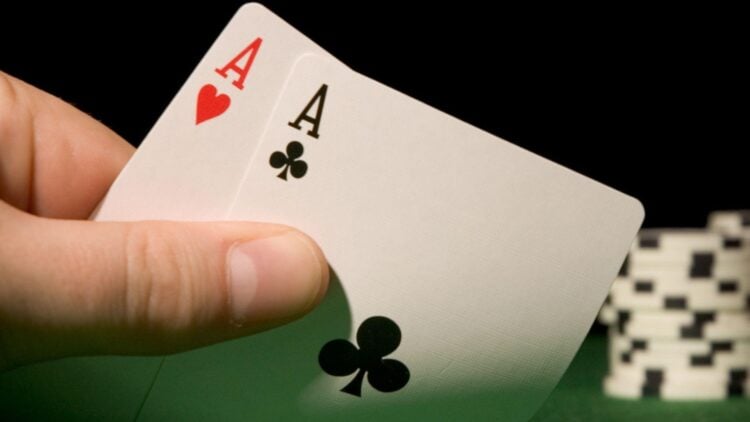
The game of Poker comes in many forms, from Texas Hold‘Em to Seven Card Stud, and many other international variations. Every game is entirely different. While many of the basic Poker rules may stay in place, each game can vary depending on the betting rules involved in the play. If you’ve never played Poker before, the betting rules can be confusing, and the countless variations definitely don’t help! But don’t worry; this is where we come in.
In this article, we will go over everything you need to know about betting in Poker, from how to bet in poker, blinds and antes, and betting limits, to Poker betting strategy. Let’s get into it!
HOW TO BET IN POKER

When playing Poker, you have five betting options. These are:
- Call: When you call, you match the betting amount of the existing bet in order to stay in the hand.
- Raise: When you raise, you raise the betting amount of the existing bet. Following players will then have to call, fold, or raise this bet.
- Fold: When you fold, you discard all your cards and take yourself out of the hand.
- Check: When you check, you stay in the hand without having to bet any extra money. This can only occur if no one else bets or raises.
- Bet: When you bet, you’re the first player to put money in the pot, starting the betting. Following players will then have to fold, call, or raise.
BLINDS AND ANTES
Blinds and antes are two different types of mandatory or forced bets placed in the pot. But what are the differences between the two?
Blind: A blind is placed by a specific player.
Ante: An ante is placed by all players.
A Poker variation like Texas Hold’em, 5 Card Draw, or Pot-Limit Omaha will use small blind and big blind as these mandatory bets. If you see a Texas Hold’em Poker cash game listed as $1/$2, this means the $1 is the small blind amount while the $2 is the big blind amount. The blinds move clockwise to the next players on the table after every hand.
Note: in most poker games, the minimum bet is generally equal to the big blind amount.
Antes, on the other hand, are mandatory for all players. For example, a $10/$20 cash game with a $5 ante means all players must put $5 in the pot at the beginning of each hand.
POKER BETTING ORDER
Generally, the player to the left of the dealer begins the betting round. And then the play moves clockwise around the table. To ensure the game remains fair and even, the player to the left of the dealer should rotate. When playing amongst friends, the best way to do this is to rotate the dealer amongst all players clockwise so that everybody gets a turn.
However, with Poker games that use a blinds system, the first round of betting begins with the player to the left of the big blind. The small blind is placed by the player to the immediate left of the dealer, and the big blind is placed by the player to the left of the player who placed the small blind.
MAIN POT AND SIDE POTS

When playing Poker, a situation may occur where a player is all-in but remaining players may still have some chips left. In this case, the pot is split into a main pot and a side pot. The main pot consists of all the chips that have been bet up until the point where the player went all in, including all chips bet to call the all-in amount. This main pot is the maximum amount the all-in player can win.
All remaining players who still have chips remaining continue playing with a side pot. All further betting actions contribute to this side pot. These players who contribute to this pot can win both the main pot and the side pot!
When the hand is over, all players still remaining in the hand reveal their cards to compete to win the main pot. And all players still remaining in the hand and contributed to the side pot compete to win the side pot. Since the main pot and side pot are separate, there’s a chance that a player can win the side pot and not the main pot.
3-BET, 4-BET, AND C-BET
If you’ve played Poker before, some terms you may have heard include 3-betting, 4-betting, and c-betting. But what are these, and how do they work?
3-BET IN POKER
The 3-bet or three-bet in Poker is the first re-raise before the flop. It is named this way since it is the third action in the betting round. In other words, if a player raises before the flop and then another player re-raises, that’s a 3-bet, as that player is the third bettor in this betting round.
4-BET IN POKER
Continuing on with the above, if you raise one more time, that’s considered a 4-bet or four-bet. As in, the 4-bet is the second re-raise in a single betting round. 4-raises are generally more common before the flop but may also occur after the flop.
C-BET IN POKER
Also called a continuation bet, a c-bet is made by the player who made the last raise before the flop and then continues with another bet on the flop. The player who made the last raise pre-flop doesn’t always get the chance to do a c-bet, but if other players check, that player may have the chance to make the first bet on the flop.
This is a great aggressive strategy for when you have a strong or weak hand. If you have a strong hand, you can build the pot. And on the flip side, if you have a weak hand, you can bluff that you have a strong hand with this strategy, placing pressure on other players.
BETTING LIMITS
There are different types of Poker game formats you can play that place limits on betting: fixed limit, pot limit, and no limit. No limit is generally the most popular format, but you can find Poker games with other types of limits as well.
To best describe the betting limits, we’ll follow the format of a $1/$2 Hold’em game.
FIXED LIMIT
Fixed limit games have fixed stakes that determine how much, or the range, in which people can bet. This is the most restrictive betting format.
Following the conditions of a Hold‘em game described above, the player who is “under the gun” or the player to the left of the big blind, has 3 possible options.
- They can call the big blind ($2); this is also called a small bet.
- They may raise. However, since it is a fixed limit game, they can only raise $2 (for a $4 bet).
- They may fold and wait for the next hand.
Therefore, players may raise in increments of $2 or the big blind. This changes on the turn and on the river; players can then bet twice the big blind, or bet in $4 increments. These are called big bets. Players may bet or call $4 and raise in $4 increments.
Fixed limit games typically limit the amount of legal raises. Generally, players tap out at three raises, after which they are required to only call or fold.
Spread limit poker is very similar to fixed limit poker. However, rather than having fixed amount players can bet, players can bet in a range (between a minimum and a maximum bet).
POT LIMIT
In Pot limit poker games, such as Pot Limit Omaha (the second-most popular Poker variant), the amount players can bet is dependent on the pot size. In other words, as the pot grows larger, so do the bets. Following our game paradigm as before, let’s examine how this would play out in a Hold‘em game. Remember, these stipulations are applicable to many poker games, although some are traditionally played with certain betting variations.
The player to the left of the big blind has the same options as in Fixed limit games; they may call, raise, or fold. However, the amount a player can raise changes. A call would be placing a $2, equal to the big blind. If a player wishes to raise, they may raise up to $7. This is determined as follows: the small blind is $1, the big blind is $2, and to call is also $2, for a total of $5. So, the $7 maximum raise is the $2 call plus the $5 raise.
A much easier way to calculate this is to calculate the size of the pot before the last bet. Then, multiply the last bet or raise by three + the amount currently in the pot.
Continuing from the above example, if the next player wants to raise, they would multiply the previous bet by three, which is $7×3 = $21. Then, they would add the $3 that was in the pot, to give a total of $24, which is the maximum bet.
NO LIMIT
No limit is the traditional betting style Hold‘em is played with. The name of this variation says everything—there are no betting limits, just on the size of the blinds.
Using our Hold‘em paradigm, the small blind and big blinds are fixed at $1 and $2, respectively. However, players may then raise up to basically any amount. However, this raise’s maximum is fixed at the number of chips in front of that player; this is also called all in.
BETTING STRATEGY

Once you get the hang of the Poker betting rules, it’s time to apply some strategy to your betting so that you can come out on top! There are many strategies you can employ, which you will be able to refine and make your own the more you play. Here are some of our top Poker betting strategies you should keep in mind—no matter what kind of Poker you are playing.
BETTING VS CALLING
First of all, you should know when to bet or raise and when to call. While calling is a passive move, betting or raising is much more aggressive.
When you call, you don’t pressure your opponent. Calling can come in handy when you want to better assess your odds by looking at other community cards. This can also help prevent other players from re-raising. But keep in mind that most Poker hands are won when a player bets and every other player folds.
When you bet or raise, your opponents have to react in one way or form. This is an effective strategy if you want to get more money in the pot, bluff, or drive out the other players.
WHEN TO CHECK IN POKER
As a general rule, you should never reduce the size of your bets in later rounds. If you’re not confident in your hand, you should either:
- Bluff and bet at least what you bet in the previous round, OR
- Check.
If you bet less than what you bet in the previous round, it’s a sign of weakness and other players may jump on that and raise the bet amount, so be careful!
WHEN TO FOLD IN POKER
It’s fun to be aggressive when you play Poker, but it’s just as important to know when to fold. Folding can help lessen your losses and can also help to better your chances of winning overall.
So, when should you fold?
- If your preflop hand is terrible. This includes low-ranking hands like low pairs, unconnected and unsuited cards, and hands with little potential for improvement.
- If you have a tell on an opposing player that indicates they have a strong hand.
- If a strong opponent raises or re-raises significantly, indicating a high likelihood of having a strong hand.
- If the pot odds don’t justify calling a bet to see the next card.
With all that said, try not to fold too much, as if you do, you can miss on opportunities to win back some money. Plus, if you fold too often, the other players will easily pick up on the fact that you can easily be intimidated and bluffed.
POKER BETTING RULES FOR BLUFFING
Of course, in Poker, you won’t always have the best cards. This is where bluffing comes in. Here are some key bluffing rules and tips to keep in mind when playing Poker:
- Bluff players who will fold: Bluff against a player who appears to have a weak hand.
- Be selective: Don’t overdo it. Bluffing too frequently can lead to predictability and make your opponents more likely to call you down with marginal hands.
- Exploit the board: Bluffs are more believable on boards that appear threatening or coordinated, as they provide a plausible reason for why you might be betting aggressively. For example, a board with three cards of the same suit or consecutive cards may suggest that you’re holding a strong hand like a flush or a straight.
- Understand your bet size: The size of your bluff bet should be consistent with the story you’re trying to tell about your hand. A small bet may not be convincing enough to represent a strong hand, while an overly large bet may look suspicious.
Want to learn more about the basics of Poker? Check out our article on Poker rules for beginners.
- 30 FUN DATE NIGHT GAMES FOR COUPLES - April 18, 2024
- 200+ INSANE “KISS MARRY KILL” QUESTIONS TO ASK - April 16, 2024
- 15 BOARD GAMES FOR 5 YEAR OLDS (THAT EVEN YOU WILL ENJOY) - November 10, 2023